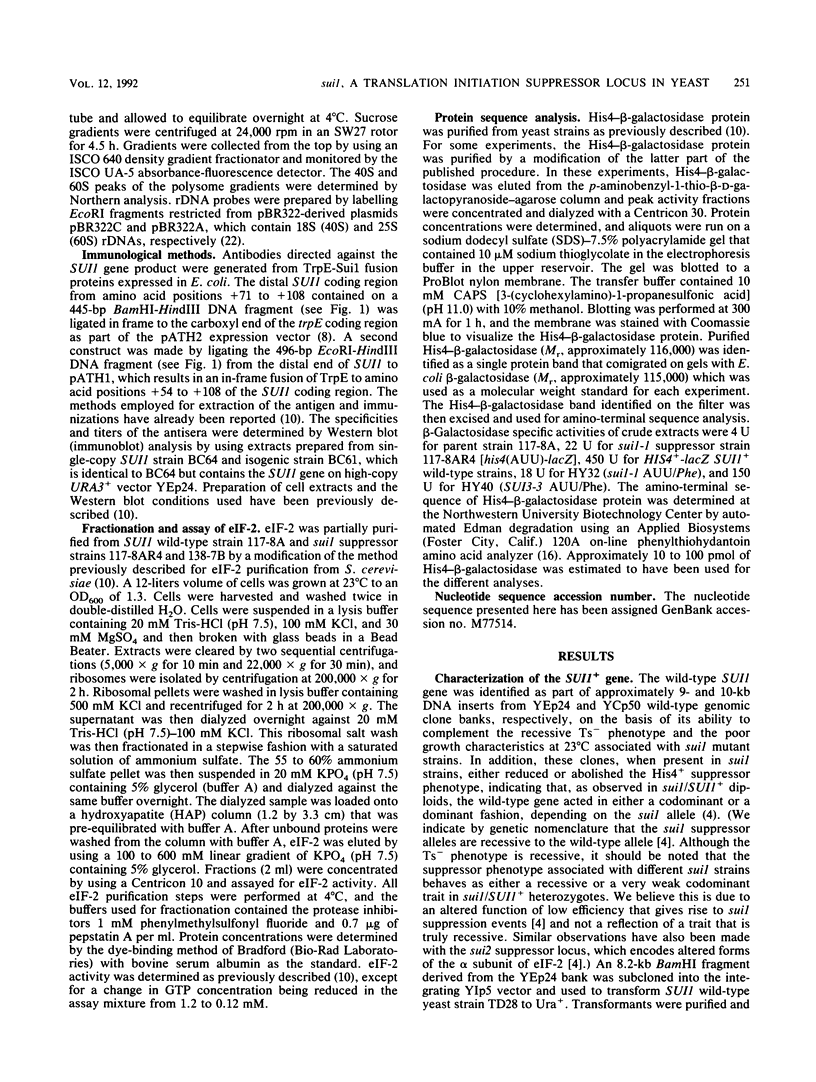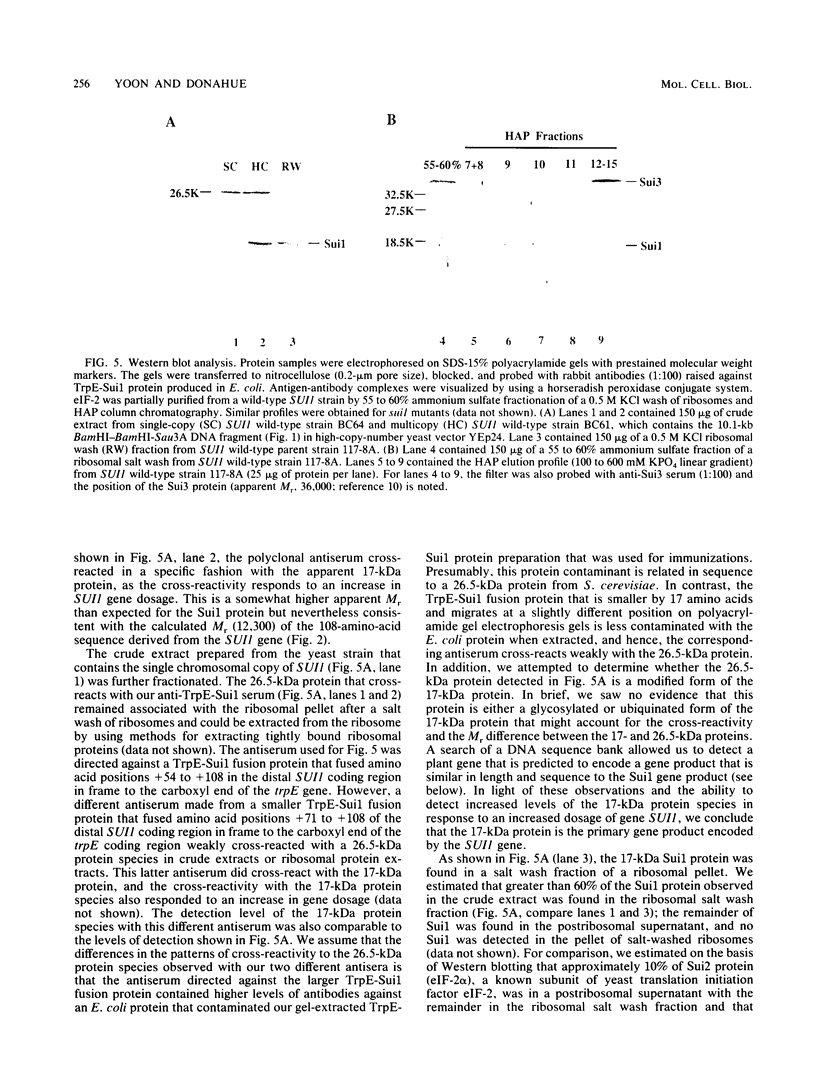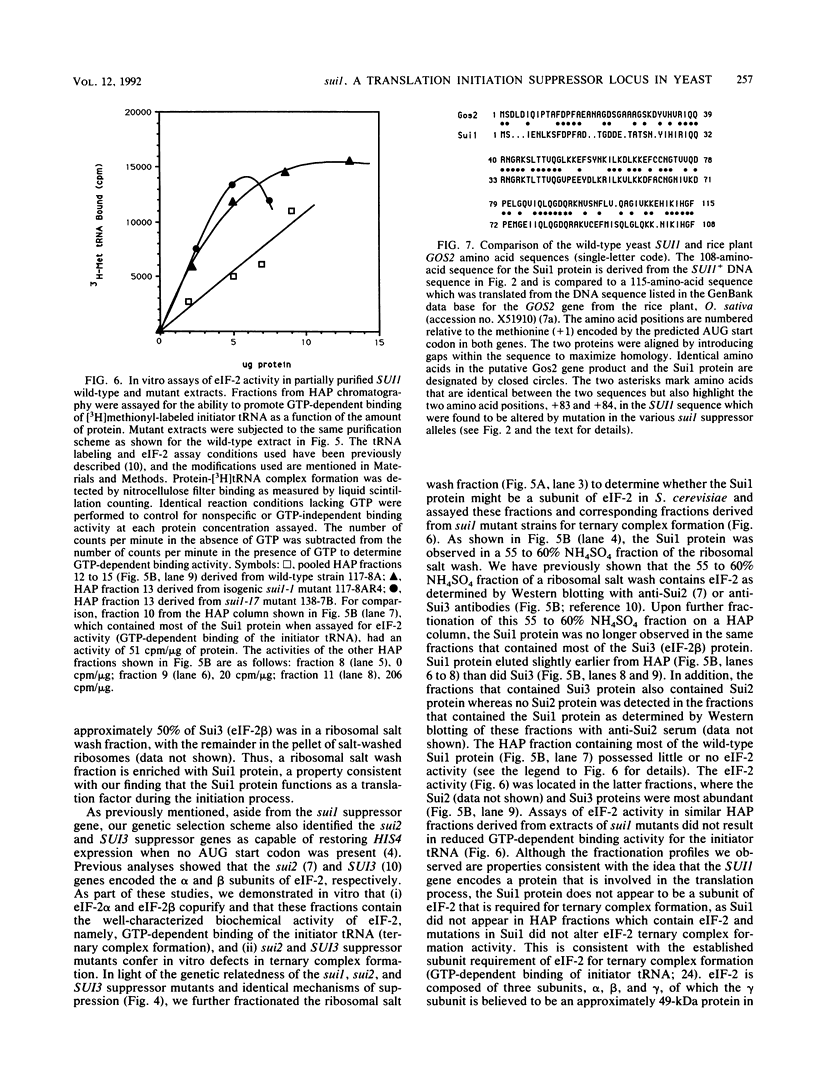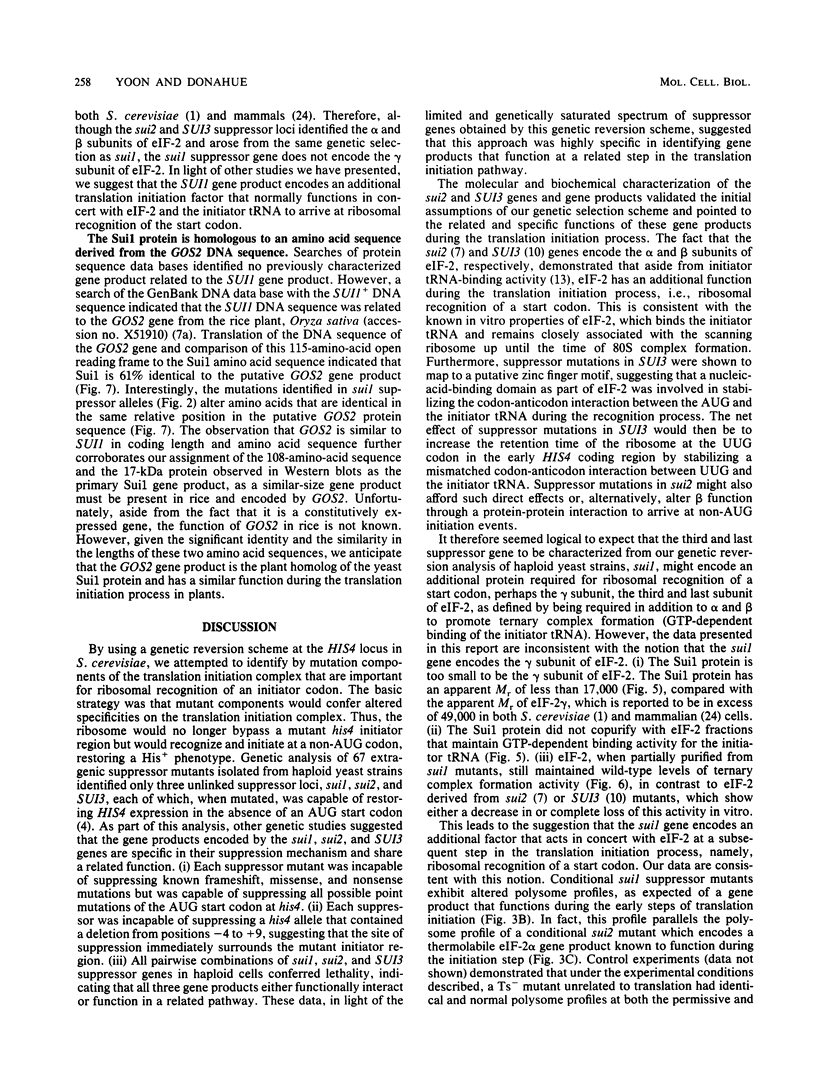Abstract
We initiated a genetic reversion analysis at the HIS4 locus to identify components of the translation initiation complex that are important for ribosomal recognition of an initiator codon. Three unlinked suppressor loci, suil, sui2, and SUI3, that restore expression of both HIS4 and HIS4-lacZ in the absence of an AUG initiator codon were identified. In previous studies, it was demonstrated that the sui2 and SUI3 genes encode mutated forms of the alpha and beta subunits, respectively, of eukaryotic translation initiation factor 2 (eIF-2). In this report, we describe the molecular and biochemical characterizations of the sui1 suppressor locus. The DNA sequence of the SUI1+ gene shows that it encodes a protein of 108 amino acids with a calculated Mr of 12,300. The sui1 suppressor genes all contain single base pair changes that alter a single amino acid within this 108-amino-acid sequence. sui1 suppressor strains that are temperature sensitive for growth on enriched medium have altered polysome profiles at the restrictive temperature typical of those caused by alteration of a protein that functions during the translation initiation process. Gene disruption experiments showed that the SUI1+ gene encodes an essential protein, and antibodies directed against the SUI1+ coding region identified a protein with the predicted Mr in a ribosomal salt wash fraction. As observed for sui2 and SUI3 suppression events, protein sequence analysis of His4-beta-galactosidase fusion proteins produced by sui1 suppression events indicated that a UUG codon is used as the site of translation initiation in the absence of an AUG start codon in HIS4. Changing the penultimate proline codon 3' to UUG at his4 to a Phe codon (UUC) blocks aminopeptidase cleavage of the amino-terminal amino acid of the His4-beta-galactosidase protein, as noted by the appearance of Met in the first cycle of the Edman degradation reaction. The appearance of Met in the first cycle, as noted, in either a sui1 or a SUI3 suppressor strain showed that the mechanism of suppression is the same for both suppressor genes and allows the initiator tRNA to mismatch base pair with the UUG codon. This suggests that the Sui1 gene product performs a function similar to that of the beta subunit of eIF-2 as encoded by the SUI3 gene. However, the Sui1 gene product does not appear to be a required subunit of eIF-2 on the basis of purification schemes designed to identify the GTP-dependent binding activity of eIF-2 for the initiator tRNA. In addition, suppressor mutations in the sui1 gene, in contrast to suppressor mutations in the sui2 or SUI3 gene, do not alter the GTP-dependent binding activity of the eIF-2. The simplest interpretation of these studies is that the sui1 suppressor gene defines an additional factor that functions in concert with eIF-2 to enable tRNAiMet to establish ribosomal recognition of an AUG initiator codon.
Full text
PDF












Images in this article
Selected References
These references are in PubMed. This may not be the complete list of references from this article.
- Ahmad M. F., Nasrin N., Bagchi M. K., Chakravarty I., Gupta N. K. A comparative study of the characteristics of eIF-2 and eIF-2-ancillary factor activities from yeast Saccharomyces cerevisiae and rabbit reticulocytes. J Biol Chem. 1985 Jun 10;260(11):6960–6965. [PubMed] [Google Scholar]
- Baim S. B., Pietras D. F., Eustice D. C., Sherman F. A mutation allowing an mRNA secondary structure diminishes translation of Saccharomyces cerevisiae iso-1-cytochrome c. Mol Cell Biol. 1985 Aug;5(8):1839–1846. doi: 10.1128/mcb.5.8.1839. [DOI] [PMC free article] [PubMed] [Google Scholar]
- Burgin A. B., Parodos K., Lane D. J., Pace N. R. The excision of intervening sequences from Salmonella 23S ribosomal RNA. Cell. 1990 Feb 9;60(3):405–414. doi: 10.1016/0092-8674(90)90592-3. [DOI] [PubMed] [Google Scholar]
- Castilho-Valavicius B., Yoon H., Donahue T. F. Genetic characterization of the Saccharomyces cerevisiae translational initiation suppressors sui1, sui2 and SUI3 and their effects on HIS4 expression. Genetics. 1990 Mar;124(3):483–495. doi: 10.1093/genetics/124.3.483. [DOI] [PMC free article] [PubMed] [Google Scholar]
- Cigan A. M., Feng L., Donahue T. F. tRNAi(met) functions in directing the scanning ribosome to the start site of translation. Science. 1988 Oct 7;242(4875):93–97. doi: 10.1126/science.3051379. [DOI] [PubMed] [Google Scholar]
- Cigan A. M., Pabich E. K., Donahue T. F. Mutational analysis of the HIS4 translational initiator region in Saccharomyces cerevisiae. Mol Cell Biol. 1988 Jul;8(7):2964–2975. doi: 10.1128/mcb.8.7.2964. [DOI] [PMC free article] [PubMed] [Google Scholar]
- Cigan A. M., Pabich E. K., Feng L., Donahue T. F. Yeast translation initiation suppressor sui2 encodes the alpha subunit of eukaryotic initiation factor 2 and shares sequence identity with the human alpha subunit. Proc Natl Acad Sci U S A. 1989 Apr;86(8):2784–2788. doi: 10.1073/pnas.86.8.2784. [DOI] [PMC free article] [PubMed] [Google Scholar]
- Dieckmann C. L., Tzagoloff A. Assembly of the mitochondrial membrane system. CBP6, a yeast nuclear gene necessary for synthesis of cytochrome b. J Biol Chem. 1985 Feb 10;260(3):1513–1520. [PubMed] [Google Scholar]
- Donahue T. F., Cigan A. M. Genetic selection for mutations that reduce or abolish ribosomal recognition of the HIS4 translational initiator region. Mol Cell Biol. 1988 Jul;8(7):2955–2963. doi: 10.1128/mcb.8.7.2955. [DOI] [PMC free article] [PubMed] [Google Scholar]
- Donahue T. F., Cigan A. M., Pabich E. K., Valavicius B. C. Mutations at a Zn(II) finger motif in the yeast eIF-2 beta gene alter ribosomal start-site selection during the scanning process. Cell. 1988 Aug 26;54(5):621–632. doi: 10.1016/s0092-8674(88)80006-0. [DOI] [PubMed] [Google Scholar]
- Donahue T. F., Farabaugh P. J., Fink G. R. The nucleotide sequence of the HIS4 region of yeast. Gene. 1982 Apr;18(1):47–59. doi: 10.1016/0378-1119(82)90055-5. [DOI] [PubMed] [Google Scholar]
- Ernst H., Duncan R. F., Hershey J. W. Cloning and sequencing of complementary DNAs encoding the alpha-subunit of translational initiation factor eIF-2. Characterization of the protein and its messenger RNA. J Biol Chem. 1987 Jan 25;262(3):1206–1212. [PubMed] [Google Scholar]
- Gupta N. K., Woodley C. L., Chen Y. C., Bose K. K. Protein synthesis in rabbit reticulocytes. Assays, purification, and properties of different ribosomal factors and their roles in peptide chain initiation. J Biol Chem. 1973 Jun 25;248(12):4500–4511. [PubMed] [Google Scholar]
- Hartwell L. H., McLaughlin C. S. A mutant of yeast apparently defective in the initiation of protein synthesis. Proc Natl Acad Sci U S A. 1969 Feb;62(2):468–474. doi: 10.1073/pnas.62.2.468. [DOI] [PMC free article] [PubMed] [Google Scholar]
- Hershey J. W. Translational control in mammalian cells. Annu Rev Biochem. 1991;60:717–755. doi: 10.1146/annurev.bi.60.070191.003441. [DOI] [PubMed] [Google Scholar]
- Hewick R. M., Hunkapiller M. W., Hood L. E., Dreyer W. J. A gas-liquid solid phase peptide and protein sequenator. J Biol Chem. 1981 Aug 10;256(15):7990–7997. [PubMed] [Google Scholar]
- Kozak M. Evaluation of the "scanning model" for initiation of protein synthesis in eucaryotes. Cell. 1980 Nov;22(1 Pt 1):7–8. doi: 10.1016/0092-8674(80)90148-8. [DOI] [PubMed] [Google Scholar]
- Kozak M. How do eucaryotic ribosomes select initiation regions in messenger RNA? Cell. 1978 Dec;15(4):1109–1123. doi: 10.1016/0092-8674(78)90039-9. [DOI] [PubMed] [Google Scholar]
- Maxam A. M., Gilbert W. Sequencing end-labeled DNA with base-specific chemical cleavages. Methods Enzymol. 1980;65(1):499–560. doi: 10.1016/s0076-6879(80)65059-9. [DOI] [PubMed] [Google Scholar]
- Nomenclature of initiation, elongation and termination factors for translation in eukaryotes. Recommendations 1988. Nomenclature Committee of the International Union of Biochemistry (NC-IUB). Eur J Biochem. 1989 Dec 8;186(1-2):1–3. doi: 10.1111/j.1432-1033.1989.tb15169.x. [DOI] [PubMed] [Google Scholar]
- Orr-Weaver T. L., Szostak J. W., Rothstein R. J. Genetic applications of yeast transformation with linear and gapped plasmids. Methods Enzymol. 1983;101:228–245. doi: 10.1016/0076-6879(83)01017-4. [DOI] [PubMed] [Google Scholar]
- Pathak V. K., Nielsen P. J., Trachsel H., Hershey J. W. Structure of the beta subunit of translational initiation factor eIF-2. Cell. 1988 Aug 26;54(5):633–639. doi: 10.1016/s0092-8674(88)80007-2. [DOI] [PubMed] [Google Scholar]
- Petes T. D., Hereford L. M., Skryabin K. G. Characterization of two types of yeast ribosomal DNA genes. J Bacteriol. 1978 Apr;134(1):295–305. doi: 10.1128/jb.134.1.295-305.1978. [DOI] [PMC free article] [PubMed] [Google Scholar]
- Rothstein R. J. One-step gene disruption in yeast. Methods Enzymol. 1983;101:202–211. doi: 10.1016/0076-6879(83)01015-0. [DOI] [PubMed] [Google Scholar]
- Sanger F., Nicklen S., Coulson A. R. DNA sequencing with chain-terminating inhibitors. Proc Natl Acad Sci U S A. 1977 Dec;74(12):5463–5467. doi: 10.1073/pnas.74.12.5463. [DOI] [PMC free article] [PubMed] [Google Scholar]
- Schnier J., Schwelberger H. G., Smit-McBride Z., Kang H. A., Hershey J. W. Translation initiation factor 5A and its hypusine modification are essential for cell viability in the yeast Saccharomyces cerevisiae. Mol Cell Biol. 1991 Jun;11(6):3105–3114. doi: 10.1128/mcb.11.6.3105. [DOI] [PMC free article] [PubMed] [Google Scholar]
- Schreier M. H., Erni B., Staehelin T. Initiation of mammalian protein synthesis. I. Purification and characterization of seven initiation factors. J Mol Biol. 1977 Nov;116(4):727–753. doi: 10.1016/0022-2836(77)90268-6. [DOI] [PubMed] [Google Scholar]
- Thomas A., Goumans H., Voorma H. O., Benne R. The mechanism of action of eukaryotic initiation factor 4C in protein synthesis. Eur J Biochem. 1980;107(1):39–45. doi: 10.1111/j.1432-1033.1980.tb04621.x. [DOI] [PubMed] [Google Scholar]



